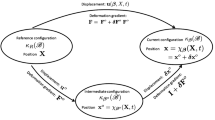Abstract
This paper deals with the application of the Virtual Fields Method to the identification of the shear modulus of a gel from Magnetic Resonance Elastography data. Volume deformation fields in the cube were recorded at different times during the harmonic loading and the full harmonic response has been reconstructed using Fast Fourier Transform. Strains were then obtained by direct spatial differentiation, without any smoothing. The VFM was then applied with inertial forces balancing out elastic forces, without including the loading force which was not measured here. It has been shown that the choice of the virtual field is critical with such a spatial wave deformation field. A wide range of spatially harmonic virtual fields has been tested at different times within the loading period. The identified shear modulus has been shown to be consistent and to correlate with the value obtained from a simplified approach based on the shear wave solution. This is a feasibility study, it will be extended in the future to heterogeneous materials with a more thorough procedure to build up relevant virtual fields.
Access this chapter
Tax calculation will be finalised at checkout
Purchases are for personal use only
Preview
Unable to display preview. Download preview PDF.
Similar content being viewed by others
Reference
Samani A., Zubovits J., Plewes D.B., Elastic moduli of normal and pathological human breast tissues: an inversion-technique-based investigation of 169 samples, Physics in Medicine and Biology, 52:1565:1576, 2007.
Venkatesh SK, Yin M, Glockner JF, Takahashi N, Araoz PA, Talwalkar JA, Ehman RL (2008) MR elastography of liver tumors: Preliminary results. American Journal of Roentgenology 52(6):1534–1540
Atay S., Kroenke C.D., Sabet A., Bayly P.V., Measurement of the dynamic shear modulus of mouse brain tissue in-vivo by magnetic resonance elastography, Journal of Biomechanical Engineering, 130:021013 (11 p.), 2008.
Li J, Cui Y, English RE, Noble JA (2009) Ultrasound estimation of breast tissue biomechanical properties using a similarity-based non-linear optimization approach. Journal of Strain Analysis 44:363–374
Muthupillai R, Lomas DJ, Rossman PJ, Greenleaf JF, Manduca A, Ehman RL (1995) Magnetic resonance elastography by direct visualization of propagating acoustic strain waves. Science 269:1854–1857
Schmitt J.M., OCT elastography: imaging microscopic deformation and strain of tissue, Optics Express, 3:199- 211, 1998. http://www.opticsinfobase.org/abstract.cfm?URI=oe-3-6-199
De La Torre-Ibarra M.H., Ruiz P.D., Huntley J.M., Double-shot depth-resolved displacement field measurement using phase-contrast spectral optical coherence tomography, Optics Express, 14(21):9643 9656.
Richards MS, Barbone PE, Oberai AA (2009) Quantitative three dimensional elasticity imaging from quasi-static deformation: a phantom study. Physics in Medicine and Biology 54:757–779
Sinkus R, Tanter M, Xydeas T, Catheline S, Bercoff J, Fink M (2005) Viscoelastic shear properties of in vivo breast lesions measured by MR elastography. Magnetic Resonance Imaging 23:159–165
Grédiac M, Pierron F, Avril S, Toussaint E (2006) The virtual fields method for extracting constitutive parameters from full-field measurements: a review. Strain: an International Journal for Experimental Mechanics 42:233–253
Avril S, Huntley JM, Pierron F, Steele DD (2008) 3D heterogeneous stiffness identification using MRI and the virtual fields method. Experimental Mechanics 48(4):479–494
Claire D., Hild F., Roux S., A finite element formulation to identify damage fields: The equilibrium gap method International Journal for Numerical Methods in Engineering, 61(2):189-208, 2004.
Giraudeau A., Pierron F., Identification of stiffness and damping properties of thin isotropic vibrating plates using the Virtual Fields Method. Theory and simulations, Journal of Sound and Vibration, 284(3-5):757 781, 2005.
Giraudeau A., Pierron F., Guo B., An alternative to modal analysis for material stiffness and damping identification from vibrating plates, Journal of Sound and Vibration, in press (available online), 2010.
Kim JH, Pierron F, Wisnom M, Avril S (2009) Local stiffness reduction in impacted composite plates from full-field measurements. Composites Part A 40(12):1961–1974
Avril S, Grédiac M, Pierron F (2004) Sensitivity of the virtual fields method to noisy data. Computational Mechanics 34(6):439–452
Avril S, Pierron F (2007) General framework for the identification of elastic constitutive parameters from full-field measurements. International Journal of Solids and Structures 44:4978–5002
Author information
Authors and Affiliations
Corresponding author
Editor information
Editors and Affiliations
Rights and permissions
Copyright information
© 2013 The Society for Experimental Mechanics, Inc.
About this paper
Cite this paper
Pierron, F., Bayly, P.V., Namani, R. (2013). Application of the Virtual Fields Method to Magnetic Resonance Elastography data. In: Proulx, T. (eds) Application of Imaging Techniques to Mechanics of Materials and Structures, Volume 4. Conference Proceedings of the Society for Experimental Mechanics Series. Springer, New York, NY. https://doi.org/10.1007/978-1-4419-9796-8_17
Download citation
DOI: https://doi.org/10.1007/978-1-4419-9796-8_17
Published:
Publisher Name: Springer, New York, NY
Print ISBN: 978-1-4419-9528-5
Online ISBN: 978-1-4419-9796-8
eBook Packages: EngineeringEngineering (R0)




